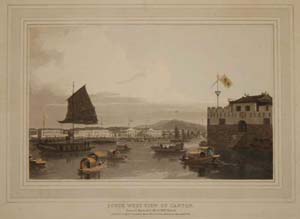Printing Techniques

Aquatint, the first type of printing used for color plate books, is a type of etching, which is an intaglio printing process. In intaglio printing, lines are incised into a plate; the ink is pressed from these lines onto a sheet of paper using high pressure. The aquatint process was originally intended to produce an imitation of a drawing in sepia or India ink, but was later discovered to represent watercolors particularly well. The printing process was done in two or three colored inks of neutral tints; printers usually used brown for the foreground and blue for the sky and distance. Other colors would be added by hand after the print came off the press. The original artist of the print would produce a template showing the colors that should appear in the plate, and colorists employed by the publisher would add the colors based on the template. Many publishers of aquatint prints had workshops where this coloring was done. Because of the use of hand coloring, books produced using aquatint were often quite expensive.
The emphasis in aquatint is on tonal rather than linear qualities; linear qualities are emphasized in etching and engraving. The essential characteristics of aquatint prints is a random grainy network which encloses tiny islands of white. This network is achieved by putting a ground on the plate; the particles in the ground prevent the acid from etching parts of the plate. The dots unaffected by the acid are, once printed, the white islands. One attraction of aquatint stems from its being only partly mechanical; the addition of colors by hand gives it a spontaneity and natural effect not seen in other forms of engraving. The early colorists of aquatints were among the pioneers of the movement to use bold contrasts and bright tints, a trend which influenced watercolor painting, allowing it to grow from its place as the eighteenth century's "tinted drawings" to a more widely used and respected art.
In contrast to aquatint, chromolithography allows color to be added during the printing stage, without the need for hand coloring. It was thus a far cheaper process. It also excelled in the reproduction of crayon drawings. For these reasons, as chromolithography was perfected, it became the preferred method of color printing. Lithographs are printed from stones, and color lithographs were by produced using different stones for different colors.
